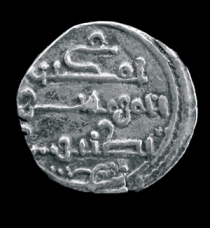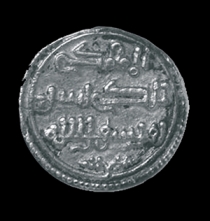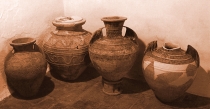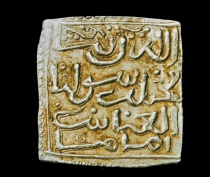Islamic Legacy and Viticulture
With the Islamic conquerors came laws that subjected the consumption of wine to conditions hitherto unknown. The consequences of these restrictions will be explored here. Firstly, it should be mentioned that the ramifications of these political waves of Islamic fundamentalism were less noticeable in Portugal, which was located geographically on its margins. There is little literature on this subject.
With the Islamic conquest in the seventh century AD a substantial portion of the vineyards in the Orient and North Africa was destroyed. It was therefore likely that a large part of the Vitis vinifera cultivars and populations was lost.
One must also bear in mind that this was where the gene pool of Vitis vinifera orientalis Negr. existed: it consisted primarily of aromatic large‑berry varieties, some of which were even seedless. Because of their physiological configurations, these varieties were ideally suited to the hot climate of the Islamic world(Turkovíc, 1961: 88). Table grape varieties, which are still at the core of table grape breeding today, were selected and respected Muslim dietary observances. Varieties such as Afus Ali, Csausch, Bicane, Geisdutte and Sultanina are still with us today.
Meanwhile, that part of Iberia occupied by Islamic peoples, known as Al‑Andalus, which had been previously ruled by governors on behalf of an Oriental Caliph, became an independent emirate (172 AH/AD 788) [AH = anno hegirae (in the year of the Hijra)].
The first four Orthodox Caliphs (the fathers‑in‑law of the Prophet Mohammed, Abu Bakr and ‘Umar, and then his sons‑in‑law, ‘Uthman and ‘Ali), resulted in the first Islamic dynasty, the Umayyad, which elected Damascus as its capital city.
It is easy to gauge the importance of wine in the Arab world from how often it has been mentioned in the Qur’an: in Sura 5 (The Table) which eventually leads to the prohibition of drinking wine; in Sura 4 (The Women), ayat 43; in Sura 2 (The Calf ), ayat 219, and elsewhere.
The Umayyad were tolerant of the culture and customs of the peoples whom they had subjugated. Peñin (2008: 135) refers to the fact that the Umayyad Caliph Abd el Rachman III was accustomed to drinking wine at his court, and tolerated it in others as long as it was in moderation. With some of the Taifas rulers who came after them, however, this was carried to its extreme in that the Taifas distinguished between wine that was permitted and wine that was prohibited. In Andalusia the Umayyad allowed the Jews, its most important community, to retain their customs. The Christians too, known as the Mozarabs, were tolerated and to a certain extent were able to practise their religion and participate in the economy. Because viticulture was important to them, vines and grapes are often found as a decorative element (Fig. 52). One sign of vineyards existing in southern Andalusia is sherry, which the Spanish author Oliver Asín (Peñin 2008: 233) says comes from the word “Sherez” from the Arabic settlement at Seris. In any case, the vineyards founded there by Afonso X of Castile in 1265 were producing wines other than today’s sherry. Wine production incurred the fundamentalists’ disapproval, because religious observances were not adequately respected. Previously, in 132 AH/AD 749, this had given the Abbassites grounds to depose the Umayyad as Caliph, to kill them all – with one exception – and to make Baghdad their capital. The sole survivor was an uncle of the last Umayyad Caliph, Hixam, who managed to flee and finally moved to Al‑Andalus. He became the first Emir Abu’l‑Mutarrif ‘Abd al‑Rahman I.
Floral and plant designs appear often in Islamic arts and crafts. The vine with grapes was the most common. At the time of the Caliphate of Cordoba, which relates to some regions in Portugal today, grapes were important to the Andalusian economy, and their image was even struck on their coins. They can be seen on various dirham coins from Al‑Andalus (Cordoba), from Madinat al‑Zahra, from the reign of Al‑Hakem II (350‑366 AH/AD 961‑976) and that of Hixam II (1st reign, 366‑399 AH/AD 976‑1009) (See Fig. 56).
Obviously, consumption of wine did not stop, even in Islamic Andalusia.And there was no shortage of excess either. Carvalho (1912: 15) writes about the Emir Abu’l‑ ‘Asi Al–Hakam I, who ruled between 206 and 238 AH/AD 822‑852, “In order to recover from the hardships of war, he circumvented the precepts and prohibitions of the Qur’an, and gave himself up to extravagant dinner parties, where dessert wines flowed in abundance.”
That the vines continued to be tended, and wine continued to be drunk is also reflected in poetry. The Rhymes of Al‑Mu‘tamid ‘Ala’llah, Taifas King of Seville (between 461 and 484 AH/AD 1069‑1091), who lived in Silves in his youth (Alves, 1987: 148, 151‑153), speak of wine. In doing so, he follows a long tradition of Islamic poets such as Hafiz Shirazi, Abu Nawas (765‑813), Yalal ud‑in Rumi, and Jayyam, to name a few. Accordingly to Juan Piqueiras Haba (in Actas del I Encuentro de Historiadores 2000) the Arabic‑Valencian lyrics were familiar to Ibn Jafaya, Al Rusafí, and Ibn Labbun, and make reference to wine pitchers and marble goblets from which the wine flowed in Valencia.
In addition to table grapes and the private consumption of wine, raisins were also common (in Portuguese: azibebe, a word which comes from the Arabic, azebibe = raisin) and were offered to visitors, or given to those suffering from loss of appetite, according to Sousa (1830: 8). Together with the table grape, they were a fixed part of Islamic culture, a phenomenon to which the survival of Portuguese Vitis vinifera gene pool owes its gratitude.
Viticulture in Málaga (600 BC), which traced back to that of the Greeks, reveals that this wine is already mentioned in Arabic Andalusian poetry, which must have had some basis in reality (Peñin 2008: 339).
With the decline of Umayyad rule, the Andalusian Caliphate fragmented into as many as thirty‑nine different Taifas principalities, which all had different restrictions regarding the consumption of alcohol. Each principality had its own tribe; for example, the Amirid in Valencia, the Tujibid in Zaragoza, the Birzalid in Carmona, the Zirid in Granada, the Hammudids in Algeciras and Málaga, and the Abbadid in Seville. Soon thereafter, it was the Taifas of Seville, Badajoz, Toledo, and Zaragoza which became the most powerful Islamic strongholds on the Peninsula.
The Islamic Schism, by the way, ended a period of weakening of Islamic forces in the face of Christian opposition which, against the will of their emasculated Iberian counterparts, led to the invasion by fundamentalist believers from the Moroccan desert who initiated areign of terror, the effects of which were felt to a lesser extent in Portugal.
Viticulture in the southern and central parts of Spain suffered infinitely more under the reign of the religious conservative Almoravids whose rule began in 1086, only to be succeeded by that of the fundamentalist Almohads in 1147. It was in that year that the first Portuguese King, Afonso Henriques, managed to recapture Lisbon. The regional rulers in Andalusia profited once again from the decline, loss of reputation and subversion within the ranks of the central Almoravid leadership. This resulted in the emergence of a fresh schism – the second generation of the (Almoravid) Taifa, which affected only the Evora, Beja and Silves regions of Portugal.
Even on the small silver quirates (coins) of the Almoravid one finds depictions of raisins and clusters of grapes, as was the case with Ibn Wazir, who was King of the Evora Taifa briefly from 540 AH/AD 1146 (Fig. 58).
There are other similar images, also with grapes, which make no reference to the sovereign, who may have been Ibn Wazir. They mention the Mahdi (indicating a belief in Allah). Mahdi Abd Allah – the son of a servant of God – also known as Mohammad Ibn Tumart, was the puritanical founder of the fundamentalist Almohad dynasty who insisted on a literal interpretation of the Qur’an.
In contrast to him, there are few references to the important religious leader and politician, Ahmed Ibn Qasi, founder and governor of the intermediate Taifa of Mértola. One interesting exception, if indeeed it does come from this leader, is a quirate from Mértola with a clear mint mark and a cluster of grapes on the obverse, and with no fewer than three on the reverse. It appears to be attributed to Ibn Qasi (Gomes, 2003: 65, AQ 01.05) as well, because we can just read “in the name of Allah (obverse)” and “in the name of the Imam, servant of Allah (reverse)”, without, however, finding any mention of the sovereign at all. This issue could also come from the period after the defeat of Ibn Qasi (540 AH/AD 1145) and his expulsion from Mértola. The fact that he was never expressly designated as an Imam lends credence to this assumption.
For the most part, however, these coinages come from the period before the invasion and occupation of Andalusia by the Almohad (541 AH/AD 1146).
One other equally anonymous quirate, which is definitely from West Andalusia and still from the Taifa period has similar embellishments, namely the pair of grape clusters. On the reverse can be seen, above the word Badajoz, the motto “Ruler of the Faithful” (Amir Al‑ Muminin), which corresponds to a title given to Caliphs at the time of the Almohad.
Quite apart from the negative impact of the Almoravid and Almohad influences on wine growing, the scientific know‑how of the Arab authors of this time needs to be highlighted, since it is they who first published works on Iberian grapevine varieties.
Yet one cannot overlook the fact that viniculture continued to decline under Almohad rule, a trend that was less marked in Portgual. Their fundamentalism was the last defense against the religious and military decline of the Iberian Muslims and the Almoravids. The Almohad’s supremacy, from 1147 to 1269, was limited in time, however, and began to lose its foothold with the Battle of Las Navas de Tolosain July 1212. With the help of the Crusaders, the reconquest of Portugal continued during this time.
The great offensive of the Almohad Caliph Abu Ya’qub Yusuf I in 1191 led to the reconquest of a large part of the territories south of the River Tagus, except for Évora. The Caliph was defeated with the failed siege of Santarém, and died from a battle wound as he fled to Seville.
After that, Islamic Arabs lost everything in Portugal. Alcácer do Sal fell in 1217, leaving the Algarve as the one remaining non Almohad Taifa kingdom. Emir Musa Ibn Mohammad Ibn Nassir Ibn Mahfuz, known as Ibn Mahfuz, ruled this area from 631 to 660 AH/AD 1233 to 1261. He lost the kingdom of the Algarve, at the time a vassal state of the King of Léon and Castile, after the great Battle of Silves in 1248.
In Spain, the military might of Caliph of the Almohad allowed him to continue to claim Islamic supremacy in the 12th and 13th centuries. With the call for a Crusade by Pope Innocent III, the Castilian troops were reinforced, and on 16 July 1212 Christian knights of different nations banded together with the troops of Alfonso VIII of Castile, Pedro II of Aragon, Sancho of Navarre and the Portuguese and French, which led to the 4th Almohad Caliph, Mohamed al Nasir, being decisively defeated in the Battle of Las Navas de Tolosa. The following two centuries saw the power of the Saracens collapse, as they failed to retain their cohesion. The sole exception was the Nasrid dynasty in Granada.
However, we believe that it is part of the (unofficial) character of Andalusia to resort tograpevine ornamentation, as we were able to discover from these quadrate dirhams which date back to the period when the Almohad were most observant of the Qur’an (Fig. 60).
Ultimately, this tradition continued for over three decades. Marques de Carvalho (1912: 15) mentions that, “In 1147, when Afonso Henriques captured Lisbon, it could be ascertained already at this time, wine, salt and fruit were the most important productsin and around Lisbon.” Other references to the presence of fossils and wine exist in the Citadel of Mértola, second Taifa of the Almoravid, from the reign of Ibn Qasi until the Admohad Caliphate (from the 11th to the 13th century), where seeds from cultivated and wild grape varieties were found;
in Silves Castle: from the first Almoravid dynasty until the first Christian conquest (from the end of the 11th until the 12th century); then from the reconquest by the Almohad until the Almohad kingdom of Ibn Mahfuz Taifa, and the final Christian occupation (beginning of the 12th century until 1248); grape seed fossils were found here.
in the Travessa da Portuguesa, in Setúbal (13th and 14th centuries) (Pais, 1996).
Ibn Battuta/(Ben Batuda) (See Fig. 55) travelled at the beginning of the 14th century for over twenty‑five years throughout the entire Orient, visiting Arab countries, Greece, Persia, India and China, describing the lifestyles he encountered on his travels. The following quotation reveals that the enjoyment of wine took obvious priority, “After I had arrived in the town he presided over, I wanted to see the local Sultan Africiato. This was not easy, because with the obvious exception of Fridays (the Muslim holy day, with an obligatory visit to the mosque), I did not know to what extent his steadfastness against the enjoyment of wine would show.” In his work, he refers ten times to the excessive enjoyment of alcohol, but mentions wine, grapes, vineyards, must and raisins (the latter being the main ingredient for making dessert wine) constantly.
In conclusion, one can say that although the consumption of wine contradicts the precepts of the Qur’an, viniculture was practised particularly in Andalusia, but also in Portugal, throughout all periods of Islamic rule. Thus, the old grapevine varieties were able to survive, whilst the genetic spectrum was broadened by the introduction of new Arab varieties.
One other important reference to the Saracens’ tolerance of Portuguese wine growing is that work by Lencastre (1953: 49 ff) which lists in chronological order hundreds of documents containing references to wine (in charters, bestowals, vineyard sale agreements, decrees, etc.) from 870 to the end of the Middle Ages.
 Fig. 55: Excerpt from the 1798 manuscript of Father José de Santos A. Moura, written based on the original “Travels” of 1356 of Sheikh Abu’ Abd Allah Mohammed, known as Ben Batuta, native of Tangiers and connected to Al-Andalus. The bilingual version (Arabic and Portuguese) of his famous travelogues provides clear proof of the presence of wine in the everyday life of Islam. Both books are housed in the Sciences Academy of Lisbon (Academia das Ciências de Lisboa).
Fig. 55: Excerpt from the 1798 manuscript of Father José de Santos A. Moura, written based on the original “Travels” of 1356 of Sheikh Abu’ Abd Allah Mohammed, known as Ben Batuta, native of Tangiers and connected to Al-Andalus. The bilingual version (Arabic and Portuguese) of his famous travelogues provides clear proof of the presence of wine in the everyday life of Islam. Both books are housed in the Sciences Academy of Lisbon (Academia das Ciências de Lisboa).
 Fig. 57: Quirate (silver coin): reverse with grapevine, tendril and two grape clusters in symmetrical arrangement, above the inscription “the (Almohad) Mahdi [or messianic redeemer of the Islamic faith], Mohammad Ibn’Abd Allah”. No mint mark. On the obverse (not shown here) under the creed: Ibn Wazir (No 1911, from Vives, 1893: 318; No SW05.03 from Gomes, 2003: 68). Orthogonal dimensions: Height 12.1mm; Width 11.9 mm. M. Telles Antunes Collection.
Fig. 57: Quirate (silver coin): reverse with grapevine, tendril and two grape clusters in symmetrical arrangement, above the inscription “the (Almohad) Mahdi [or messianic redeemer of the Islamic faith], Mohammad Ibn’Abd Allah”. No mint mark. On the obverse (not shown here) under the creed: Ibn Wazir (No 1911, from Vives, 1893: 318; No SW05.03 from Gomes, 2003: 68). Orthogonal dimensions: Height 12.1mm; Width 11.9 mm. M. Telles Antunes Collection.
 Fig. 58: Quirate: reverse with grapevine and two grape clusters in symmetrical arrangement under inscription of the motto, “The Madhi impart Allah’s religion and is sent by Allah”. Mint mark and sovereign unknown. (possibly Ibn Wazir). Coin not mentioned by Vives e Escudero (1893). Orthogonal dimensions: Height 11.2 mm; Width 11.4 mm; unpublished. M. Telles Antunes Collection.
Fig. 58: Quirate: reverse with grapevine and two grape clusters in symmetrical arrangement under inscription of the motto, “The Madhi impart Allah’s religion and is sent by Allah”. Mint mark and sovereign unknown. (possibly Ibn Wazir). Coin not mentioned by Vives e Escudero (1893). Orthogonal dimensions: Height 11.2 mm; Width 11.4 mm; unpublished. M. Telles Antunes Collection.
 Fig. 59: Quirate. Obverse: Embellishment with grapevine and two grape clusters in symmetrical arrangement under the inscription. Date and sovereign not marked (Ibn Wazir?). Minted at: Badajoz N.o 1988 de Vives (1893: 333) Orthogonal dimensions: Height 10.4 mm; Width 10.6 mm. M. Telles Antunes Collection.
Fig. 59: Quirate. Obverse: Embellishment with grapevine and two grape clusters in symmetrical arrangement under the inscription. Date and sovereign not marked (Ibn Wazir?). Minted at: Badajoz N.o 1988 de Vives (1893: 333) Orthogonal dimensions: Height 10.4 mm; Width 10.6 mm. M. Telles Antunes Collection.










